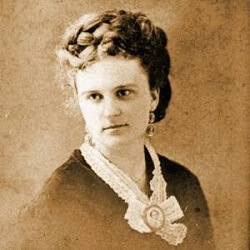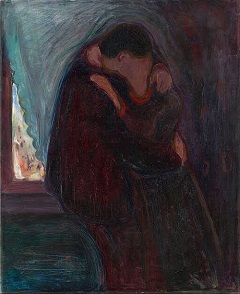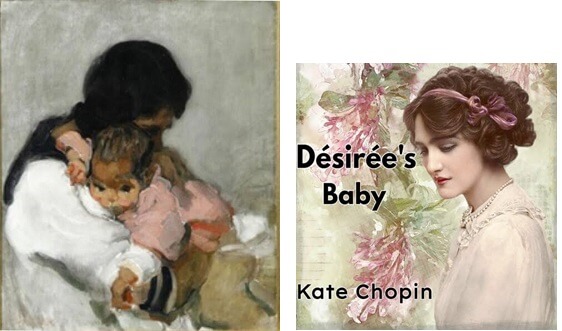Kate Chopin
Kate Chopin, born Katherine O'Flaherty (February 8, 1851 - August 22, 1904), was a Louisiana-born American author of short stories and novels. Scholars consider her to be a forerunner of American 20th-century feminist authors of Southern or Catholic background, such as Zelda Fitzgerald, and she is one of the most widely read and recognised writers of Louisiana Creole heritage. She is best known today for her 1899 novel The Awakening. Chopin was born in St. Louis, Missouri, of maternal French and paternal Irish ancestry. She married and moved to New Orleans with her husband. They later moved to Cloutierville, Louisiana, and lived in the country. Chopin wrote short stories for children and adults published in national magazines such as Atlantic Monthly, Vogue, The Century Magazine, and The Youth's Companion from 1892 to 1895. Her stories sparked debate because of their subjects and approach; some critics called them immoral. Her most notable works included two short story collections and two novels. Bayou Folk (1894) and A Night in Acadie (1895) are the titles of the collections (1897). "Désirée's Baby" (1893), a story of miscegenation in antebellum Louisiana, "The Story of an Hour," and "The Storm" were among her notable short stories (1898). "The Storm" is the sequel to "At the Cadian Ball," which appeared in her first short story collection, Bayou Folk. Chopin also wrote two novels, At Fault (1890) and The Awakening (1899), both set in New Orleans and Grand Isle, respectively. Her characters are mainly from Louisiana, and many are Creoles of various ethnic or racial backgrounds. Many of her works are set in Natchitoches, Louisiana, where she grew up. Within a decade of her death, Chopin was widely recognised as one of the leading writers of her time. In 1915, Fred Lewis Pattee wrote, "some of [Chopin's] work is equal to the best that has been produced in France or even in America. Early LifeKatherine O'Flaherty Chopin was born in St. Louis, Missouri. Her father, Thomas O'Flaherty, was a successful businessman from Galway, Ireland, who immigrated to the United States. Eliza Faris, his second wife, was a well-connected member of St. Louis' ethnic French community as the daughter of Athénase Charleville, a Louisiana creole of French Canadian descent. Chopin's forefathers were among the first European (French) settlers on Dauphin Island, Alabama. Kate was the third of five children, but her sisters died when she was young, and her half-brothers (from her father's first marriage) died when they were in their early twenties. They were raised in the Roman Catholic traditions of France and Ireland. She became a voracious reader of fairy tales, poetry, religious allegories, and classic and contemporary novels. In 1868, she graduated from Sacred Heart Convent in St. Louis. Chopin suffered from depression following the deaths of her husband, her business, and her mother. Dr. Frederick Kolbenheyer, Chopin's obstetrician and family friend, suggested she start writing because he thought it would be therapeutic for her. He recognised that writing could be both a focus for her extraordinary energy and a source of income. Chopin's short stories, articles, and translations began to appear in periodicals, including the St. Louis Post-Dispatch newspaper and literary magazines by the early 1890s. She was regarded as a regional writer who provided local colour during a period of significant publishing of folk tales, works in dialect, and other elements of Southern folk life. Her literary abilities were overlooked. Her second novel, The Awakening, was published in 1899. Some newspaper reviewers praised the novel. However, the critical response was overwhelmingly negative. The behaviour of the novel's characters, particularly the women, and Chopin's general treatment of female sexuality, motherhood, and marital infidelity, according to critics, conflicted with prevailing moral standards and was thus offensive. Her best-known work, this novel, tells the story of a woman trapped within the confines of an oppressive society. It was out of print for several decades before being rediscovered in the 1970s, during a wave of new studies and appreciation for women's writings. Since then, the novel has been reprinted and is widely available. It has received critical acclaim for the quality of its writing and its significance as an early feminist work from the South. According to critics, works like The Awakening were scandalous and thus were not socially accepted. Chopin was deeply discouraged by the lack of acceptance, but she persisted in writing, switching to the short story. She published "The Gentleman from New Orleans" in 1900 and was listed in the first edition of Marquis Who's Who in the same year. She never made much money from her writing, relying instead on investments she made locally in Louisiana and St. Louis from her mother's estate. Chopin suffered a brain haemorrhage while visiting the St. Louis World's Fair on August 20, 1904. She passed away two days later at the age of 54. She was laid to rest in St. Louis' Calvary Cemetery. Writing Styles
Kate Chopin lived in a variety of places, each with its own economy and society. These were sources of insights and observations she used to analyse and express her thoughts on late-nineteenth-century Southern American society. She was raised by predominantly ethnic French women. She based many of her stories and sketches on her life in Louisiana after moving to areas influenced by the Louisiana Creole and Cajun cultures with her husband. They expressed her unusual portrayals of women as individuals with separate wants and needs (at the time). Chopin's writing style was influenced by her admiration for the short stories of contemporary French writer Guy de Maupassant. Kate Chopin is an example of a revisionist mythmaker because she revises myths about marriage and female sexuality in her time more realistically. The "Victorian notion of women's somewhat anaemic sexuality" was the most significant myth Chopin focused on, and "The Storm" is the best example of Kate Chopin using that myth through a character set on fulfilling her full sexual potential. For example, in "The Storm," Kate Chopin revised portraits of women to achieve consummation in roles other than marriage to reveal a passionate nature deemed inappropriate by Victorian America's conventional, patriarchal standards. Few writers in the mid-to late-nineteenth century were brave enough to address the issues that Chopin did. Emory University's Elizabeth Fox-Genovese wrote, "Kate was neither a feminist nor a suffragist, she said so. She was nonetheless a woman who took women extremely seriously. She never doubted women's ability to be strong." Kate Chopin's sympathies were with the individual in their personal life and society. Chopin wrote a kind of autobiography and described her clubs through her stories; she grew up during a period when her surroundings included the abolitionist movements before the American Civil War and their influence on freedmen's education and rights afterwards, as well as the emergence of feminism. Her ideas and descriptions were not journalistic, but her stories captured the reality of her world. Chopin was fascinated by her surroundings and wrote about many of her observations. Chopin's writings are regarded as a new feminist voice by Jane Le Marquand, while other intellectuals regard them as the voice of an individual who happens to be a woman. "Chopin undermines patriarchy by endowing the Other, the woman, with an individual identity and sense of self, a sense of self to which the letters she leaves behind give voice," Marquand writes. "The 'official' version of her life, that constructed by the men around her, is challenged and overthrown by the woman of the story." Chopin appeared to be expressing her faith in women's strength. Marquand's work is informed by theories of creative nonfiction. Marquand writes that for a story to be autobiographical or even biographical, there must be a nonfictional element. Still, the author often exaggerates the truth to spark and hold the reader's interest. Kate Chopin might have been surprised to learn that her work has been described as feminist in the late twentieth and early twenty-first centuries, just as it had been described as immoral in her own time. Critics often regard writers as individuals with more significant points of view that address various factions in society. Works
Kate Chopin began her writing career with her first story published in the St. Louis Post-Dispatch. By the early 1890s, Chopin had developed a successful writing career, contributing short stories and articles to local publications and literary journals. She also initially wrote a number of short stories such as "A Point at Issue!", "A No-Account Creole" and "Beyond the Bayou" was published in various magazines. In 1890, her first novel, "At Fault," about a young widow and the sexual constraints of women, was published privately. The protagonist demonstrated the initial theme of Kate Chopin's works when she began writing. In 1892, Kate Chopin produced "Désirée's Baby", "Ripe Figs", and "At the 'Cadian Ball", which appeared in Two Tales that year, and eight of her other stories were published. "Désirée's Baby" is a short story about Kate Chopin's experience with miscegenation and the communities of Creoles of Color in Louisiana. Slavery was institutionalised in St. Louis and the South when she was a teenager. In Louisiana, communities of free people of colour had formed, particularly in New Orleans, where formal arrangements for plaçage, a type of common-law marriage, were made between white men and free women of colour or enslaved women. She lived in a society that was heavily based on the history of slavery and the continuation of plantation life, both there and in the country. Mixed-race people (also known as mulattos) were numerous in New Orleans and the South. This story addresses the racism of 19th century America; visibly, European-American persons could be threatened by the revelation of also having African ancestry. Chopin was not afraid to address such issues, which were often suppressed and intentionally ignored. Her character Armand tries to deny this reality when he refuses to believe that he is of partial black descent, as it threatens his ideas about himself and his status in life. R. Chopin's story, according to R. Foy has attained the level of fantastic fiction, in which the only proper subject is "human existence in its subtle, complex, true meaning, stripped of the view with which ethical and conventional standards have draped it." The story can also be viewed from a feminist standpoint, in which the white wife is unfairly punished for giving birth to a partially black child. "Desiree's Baby" was first published in an 1893 issue of Vogue magazine, alongside another of Kate Chopin's short stories, "A Visit to Avoyelles," under the heading "Character Studies: The Father of Desiree's Baby - The Lover of Mentine." "A Visit to Avoyelles" typifies Chopin's local colour writing and is one of her stories that depicts a couple in a completely fulfilled marriage. While Doudouce wishes otherwise, he sees ample evidence that Mentine and Jules' marriage is happy and fulfilling, despite their poverty-stricken circumstances. In contrast, "Desiree's Baby," which is much more controversial due to the topic of miscegenation, depicts a troubled marriage. The other contrasts in "A Visit to Avoyelles" are quite obvious, though some are more subtle than others. Armand and Desiree, unlike Mentine and Jules, are wealthy and own slaves and a plantation. Mentine and Jules' marriage has survived many adversities, whereas Armand and Desiree's crumbles at the first sign of trouble. Kate Chopin was a gifted writer who showed many sides of marriages and local people and their lives, making her writing very broad and sweeping in scope, despite the fact that she had many common themes in her work. Martha Cutter argues that Kate Chopin demonstrates feminine resistance to patriarchal society through her short stories. Cutter claims that Chopin's resistance can be traced through the timeline of her work, with Chopin becoming more and more understanding of how women can fight back suppression as time progresses. To demonstrate this, Cutter claims that Chopin's earlier stories, such as "At the 'Cadian Ball," "Wiser than a God," and "Mrs. Mobry's Reason" presents women who resist outright and are therefore not taken seriously, erased, or called insanely. However, in Chopin's later stories, the female characters take on a different voice of resistance, one that is more "covert" and works to undermine patriarchal discourse from within. Cutter exemplifies this idea by presenting Chopin's works written after 1894. Chopin, according to Cutter, wanted to "disrupt patriarchal discourse without being censored by it." To accomplish this, Chopin used a variety of strategies in her writings, including silent women, overly resistant women, women with a "covert voice," and women who mimic patriarchal discourse. In 1893, she published "Madame Célestin's Divorce," the first of thirteen stories she wrote. Vogue published "The Story of an Hour" and "A Respectable Woman" for the first time in 1894. Kate Chopin's success in 1894 with Bayou Folk, a collection of twenty-three of Chopin's stories, was published by Houghton Mifflin. It was her first national success, and it was followed by another collection of short stories, A Night in Acadie (1897). Between 1889 and 1904, Kate Chopin wrote the majority of her short stories and novels. During her career as a fiction writer, Chopin wrote approximately a hundred short stories or novels; her short stories were published in a number of local newspapers, including the St. Louis Post-Dispatch. Many of her short stories have also appeared in national magazines such as Youth's Companion and Harper's Young People. Bayou Folk received rave reviews, with Chopin writing that she had seen "a hundred press notices" about it. These pieces appeared in the New York Times and the Atlantic. People liked how she used local dialects to make her characters feel more authentic and relatable. In addition, she published two novels, At Fault and The Awakening. In comparison to her short stories, her novels were not well received at first. The overt themes of female sexuality in her 1899 novel The Awakening, as well as the female protagonist constantly rebuking societal gender roles and norms, were considered immoral. There were rumours that the novel was initially banned, but these have since been debunked. Local and national newspapers gave Chopin's novel mixed reviews, with one calling it "poison" and "unpleasant," adding that it was "too strong a drink for moral babes," while another called it "A St. Louis Woman Who Has Turned Fame Into Literature." The majority of The Awakening's early reviews were overwhelmingly negative. One of Chopin's most well-known biographers, Emily Toth, thought she had gone too far with this novel. She claimed that Edna, the protagonist, and her overt sensuality were too much for the male gatekeepers. So much so that the publication of her next novel was postponed. Nonetheless, it wasn't until Per Seyersted, a Norwegian professor and scholar, rediscovered Chopin almost 70 years later that the general public began to recognise her work as essential Feminist and Southern literature from the nineteenth century. Seyersted stated that she "broke new ground in American Literature." According to Emily Toth, Kate Chopin's work gained popularity and recognition during the 1970s due to themes of women breaking free from societal constraints, which appealed to people involved in feminist activism and the sexual revolution. She also claims that the works were popular among women in the 1960s, "a time when American women yearned to know about their feisty foremothers." Chopin was placed in the same feminist categories as Louisa May Alcott, Susan Warner, and Emily Dickinson by academics and scholars. Parallels have been drawn between Alcott and Chopin in that both authors wrote about women who departed from their traditional roles by dreaming of or striving for independence and individual freedoms, which has been described as a dramatisation of a woman's struggle for selfhood. According to a Choice Reviews reviewer, it was ultimately a futile struggle because her society's patriarchal conventions restricted her freedom. Karen Simons felt that the novel's ending, in which Edna Pontellier ends her life because she realises she cannot be both the traditional mother and have a sense of herself as an individual at the same time, perfectly captured this failed struggle. Honours and PrizesAlexis Cloutier built her Cloutierville home with Oscar Chopin in the early nineteenth century. Because of her literary significance, the house was designated as the Kate Chopin House, a National Historic Landmark (NHL), in the late twentieth century. The house was converted into the Bayou Folk Museum. The house was destroyed by fire on October 1, 2008, with only the chimney remaining. Chopin was honoured with a star on the St. Louis Walk of Fame in 1990. In 2012, an iron bust of her head was erected across the street from Left Bank Books at the Writer's Corner in St. Louis' Central West End neighbourhood.
Next TopicKylie Jenner
|
 For Videos Join Our Youtube Channel: Join Now
For Videos Join Our Youtube Channel: Join Now
Feedback
- Send your Feedback to [email protected]
Help Others, Please Share










